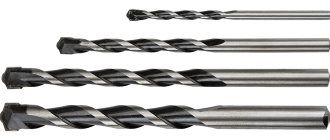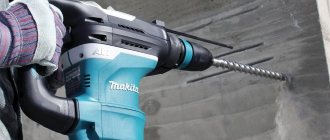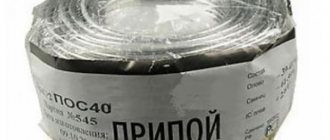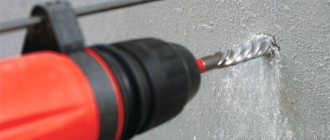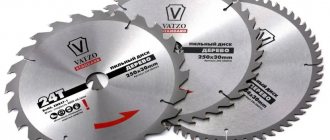During construction or renovation, it is often necessary to drill holes in concrete and stone with a hammer drill. In order for the drilling process to proceed quickly, it is necessary to select the correct concrete drill for the hammer drill. Many people mistakenly think that they can make holes in such material with simple drills. But in fact, during the drilling process, ordinary consumables quickly bend and become dull. This article will discuss the criteria for choosing a drill for a hammer drill. To make it easier to understand, the most popular blastholes from well-known world brands will be listed today.
Types of boreholes
Drill for a hammer drill: selection of impact-cutting attachment, its purpose
When carrying out construction or renovation work on an object, you often have to make holes in a brick, stone or concrete wall. For this, a special electromechanical tool in the form of a hammer drill is used. It is equipped with a working replaceable nozzle, which carries out rotational and impact movements. The hammer drill is available in several versions. Therefore, when choosing a product, you should take into account its design. Step drill: sizes and varieties, application (read more)
A hammer drill is a working impact-cutting replaceable part of an electromechanical tool.
How to choose the right one
When planning to buy a drill for processing concrete, it is important to consider the purpose of the tool, intensity of use, type of surfaces, and other points. The price per piece depends on the brand and country of production, materials, type of nozzle (for amateur or professional use).
It is recommended to pay special attention to the inclination of the spiral element: the larger it is, the deeper you can drill into the concrete coating. The same criterion affects the processing speed.
A drill for concrete hammer drills is a popular attachment that should be selected taking into account the volume and complexity of the work. On the market you can find products of domestic and foreign production; devices from the brands Sturm, Makita and Bosch are considered especially reliable.
What is a hammer drill: features of the replaceable tool element
A drill is a working impact-cutting replaceable part of an electromechanical tool. In appearance it looks like a drill. For a hammer drill, the nozzle is made of a more durable material. It is equipped with a tail section with special grooves. Characterized by a wide range of sizes. The concrete drill has characteristic features in the form of a spiral-shaped structure of the section, a unique geometry of the edge for threading.
Hammer drills come in various shapes and sizes.
The drill consists of a landing shank, a spiral rod and a cutting part. By means of the tail end, the element is fixed in the tool chuck. The spiral rod is the working part. It is designed to remove residual dust and drilled concrete from holes. The basis of the element is the cutting part.
The drill is made from several materials. Alloy tool steel is used to make the surface. The cutting edge is additionally tipped with diamond or pobedit. This manufacturing technology allows you to increase the performance of the product and increase its service life.
On a note! To increase the service life of the consumable element for a rotary hammer, before starting work, the chuck and shank must be coated with a special lubricant.
A hammer drill is a consumable item for a tool and is used to make holes in a concrete, brick or stone surface. You cannot drill into metal or wood with this attachment. This is due to the specific design of the cutting part. For this purpose, exclusively metal drills for hammer drills are used.
A hammer drill is used to make holes in brick, concrete or stone surfaces.
Concrete drills are available in various sizes. For household use, for a small hammer drill it is enough to purchase an attachment with a diameter of 6-10 mm. In this case, a dowel of the appropriate size is selected. The maximum diameter of the product reaches 50 mm. To secure large objects, use a long drill with a diameter of 20 mm. The length of the product can be 10, 50, 80 and 100 cm. When manufacturing drills, a strict ratio between diameter and length must be observed to ensure efficient, reliable and durable operation of the nozzle.
On a note! Information about the diameter and length of the product is displayed in its marking.
Drill and drill. What is the difference?
A drill is a tool that is an accessory of a drill. The main purpose of a drill is drilling. Although there are devices that have a striking function, this is in addition to drilling. In a rotary hammer, on the contrary, the first place is given to the function of impact and crushing of material, which is complemented by the possibility of rotation. The accessories for these two tools are similar in appearance, but they can be interchanged. This is due to the fact that the drill in the hammer drill does not have a rigid mount for quick change of equipment. And the drill has a jaw chuck, and there is a rigid fastening here.
Now let's look at the differences in the design of these two tools. The drill shank is a smooth surface with a simple shape. And the drill shank has the shape of a cylinder with protrusions and recesses, which is called SDS-plus and SDS-max. The grooves of the drill have a sharp edge, with their help they cut holes in the material being processed. This design for hammer drills is designed to remove residual material. Drills also differ in their design according to their purpose for a specific material. For example, drills for metal have different head sharpening angles, and for working with wood, the tool has a self-centering head.
Drill: This is an impact-cutting tool, not a drill
The drill and the drill are similar in appearance. Both consumable options are used to make through holes or recesses in a cylindrical configuration. This attachment is used for plastic, metal and wood.
For dense, non-shock-absorbing surfaces such as concrete, stone or brick, only a hammer drill is used. As a result, we can clearly answer the question of how to drill a concrete wall with a conventional drill. No, a hammer drill with a drill is used for this.
The main difference between a drill and a drill is the type of surface being processed.
Impact cutting tools in the form of a drill are much stronger than drills. The dimensions of the drill also exceed the diameter of this type of attachment. The maximum cross-sectional value of a drill is 14 mm, and for a drill this value reaches 55 mm. The design of the shank also differs. The drill has recesses, but the drill does not have grooves. The length of the nozzles is also different. Drills are available in sizes up to 300 mm, and the length of the drill reaches 1 m.
The drill can be used as an attachment for both impact and non-impact hammer drills. A drill is not used for this attachment. The drill is equipped with a head with different edges and several cutting inserts. Some models of attachments have a special geometry, thanks to which the tool can be held in the center of the recess. Drills are characterized by low productivity, and the drill can operate for a long time under conditions of high shock load.
Voting for the best drilling tool for the dacha
Which drilling tool would you choose or recommend?
ELITECH BM 52E 2.5 HP
7.78 % ( 7 )
MAXCUT MC 55 3 HP
12.22 % ( 11 )
Fiskars QuikDrill Fiskars
20.00 % ( 18 )
Bison 39491-250
4.44 % ( 4 )
PATRIOT 742104425
8.89 % ( 8 )
Tornadica pro
24.44 % ( 22 )
Sibrtech 64503
1.11 % ( 1 )
Bison 39491-200
3.33 % ( 3 )
CALIBER NSHU-200/ZEM
5.56 % ( 5 )
Classification of impact cutting attachments for rotary hammers
The impact-cutting consumable element of a hammer drill can be classified depending on its design, which determines the scope of use of the element.
An auger drill is a self-sharpening element, which is used primarily when drilling holes of considerable depth. It is characterized by high strength, endurance, efficiency, the ability to remove crumbs formed in the hole, and durability under harsh operating conditions.
Impact cutting attachments for rotary hammers are classified by design.
A drill in the form of a regular auger drill is used to create holes in a cylindrical configuration. A pike is used for concrete work. Thanks to its special configuration, it is able to create wide openings. Acts like an electric hammer.
A chisel is used to dismantle materials. A special type of impact-cutting element in the form of a crown is designed for installing electrical sockets. With the help of such a drill, a deep hole of the correct rounded configuration is created. It can be safely used when making grooves for laying pipes for water supply.
A wood drill is several times more efficient than a similar type of drill. This helps to reduce working effort, quickly separate chips, and preserve the wood structure under the influence of such a cutter. An earth drill is used to create round holes in the ground, which is achieved thanks to the special structure of the cutting rod. A concrete drill makes holes in concrete, brick and stone surfaces.
Drill for concrete hammer drill: types of element
The construction drill is classified by the design of the spiral part, the type of shank and the shape of the cutting part. Based on the design of the spiral rod, consumable elements for a hammer drill are auger, spiral and flat.
Flat-type drills are not recommended for use with low-power hammer drills.
The auger drill has a large angle of inclination of the spiral groove, which makes it possible to make deep holes. It also features a self-sharpening pobedit tip. The specific design of the auger spare part for the rotary hammer facilitates the effective removal of dust and concrete particles from the holes.
The spiral drill has small angles of inclination of the spiral. It is used to create shallow holes. The latter type of tool is characterized by a large spiral angle, which ensures high speed of drilling holes and effective removal of dust from them. A shallow drill is designed for shallow holes. This is the most popular version of the consumable material, which is distinguished by its endurance. It significantly increases the productivity of the hammer drill, while simultaneously increasing the load on it.
Note! For a low-power hammer drill, it is not recommended to use a flat-type drill.
According to the type of sharpening of the cutting edge, concrete drills are classified as classic and centering. In the first option, the carbide insert is represented by a tetrahedral design with front and rear edges. Tips for such sharpening are equipped with one or two cutting edges.
The type of sharpening of the cutting edge of a drill for concrete is classic and centering.
The centering type of nozzle is a modernized version of the classic design. The main advantage of such an element is the absence of the effect of displacement of the drill relative to its original position.
Types of drills
There are two types of tools:
- disk. The product is equipped with two semicircular blades, which are placed one above the other. To drill a hole with such a drill, the operator moves it back and forth;
Disc drill - screw It uses a solid blade that is wound around a base. To drill with this drill, you need to move clockwise.
Auger drills
Drill for a hammer drill: classification of element by shank type
Nozzles for concrete can be classified based on the design of the shank. The most popular type is the SDS Plus drill for a hammer drill, which is often used for household and semi-professional tools. It is equipped with a shank with a diameter of 10 mm, which is a cylindrical base with grooves. These recesses are necessary for reliable connection of the consumable to the tool.
The nozzle contains 4 grooves. Two of them are solid or closed, and the other two are open. The length of the tail is 40 mm. The diameter of the working edge is in the range of 4-26 mm.
Another type of concrete drill, SDS Max, has a tail diameter of 18 mm. Its length is 90 mm. In terms of the design of the grooves, this drill is similar to the previous version. The main difference is the difference in the diameters of the working part. For this type, this value starts from 26 mm. This type of replacement attachment is used for semi-professional tools and jackhammers.
The most popular type of drill bit for a rotary hammer is the SDS Plus.
An infrequently used option is the SDS Top hammer drill attachment. In terms of design, it is something in between the two previous types of products. Its cylindrical part has a diameter of 14 mm. The length of the shank is 70 mm. The diameter of the working part of the nozzle is in the range of 16-26 mm.
The structure of the SDS Quick attachment most closely resembles a drill. The tail rod has a hexagonal design. Instead of grooves, it is equipped with veneers or projections, thanks to which it is fixed in the hammer drill chuck. This 6 mm drill bit (diameter) can be used not only for rotary hammers, but also for drills and screwdrivers.
Note! The SDS Quick drill bit is exclusively suitable for Bosch power tools – models Uneo and Uneo Maxx.
The SDS Quick drill is only suitable for Bosch rotary hammers.
The new shank design features a Spline concrete drill. This spline design was developed by a Chinese company that specializes in the manufacture of rotary hammers. The new generation nozzle is gradually replacing other analogues, proving its effectiveness and reliability.
Drills for concrete: types of soldering
The cutting part of the drill has a special brazing made of carbide materials, which ensures efficient operation of the bit. If it is worn out, such a product is unsuitable for further use. Based on the material used for soldering, concrete hammer drills can be divided into subtypes.
Pobedite nozzles are made from an alloy of two high-strength materials in the form of cobalt and tungsten carbide. The first element forms the basis of the product, the second is used as a hardener. Pobedite alloy is also widely used for the manufacture of crowns and drill bits for concrete drills. The hardness of the material is 80-90 HRA on the Rockwell scale.
Diamond drills are characterized by high strength and durability, which is accompanied by a fairly high cost of the products. Diamond is applied to the cutting edge, not in the form of a solid crystal, but by sputtering, which is quite enough to increase the strength characteristics of the nozzle without significantly increasing its cost. It is advisable to use such hammer drill attachments for drilling reinforced concrete structures, granite and marble. There are also crown modifications of diamond-coated concrete nozzles.
Pobedit bits have a Rockwell hardness of 80-90 HRA.
The drill can be equipped with a pobedite insert, which is formed by immersing the element in a carbide material. This increases the wear resistance, strength and durability of the product, which can make up to 200 holes. You can distinguish such a nozzle by its appearance. It is characterized by a light colored tip.
A budget option for a drill, which is not characterized by durability, is a hardened product. This element has a dark tip, which indicates additional processing. Durable materials are not used to make such attachments. They are distinguished by their low price and wide distribution, since they are produced by underground manufacturers.
Characteristic features of earth drills
The attachment used to make holes or holes in the ground is called a hole drill. It is widely used in various fields of economic activity and makes holes with a circular cross-section. An earth drill for a hammer drill is necessary when arranging a site, installing pillars, creating a pile foundation, erecting gazebos or arches, installing a fence, laying utilities, constructing wells or boreholes. The nozzle is made of a thick-walled pipe, a metal sheet, a metal drill, and a steel disk.
Note! The hole drill can be used with a hammer drill with a power of at least 850 W.
The attachment for a hammer drill, which is used to make holes in the ground, is called a hole drill.
The hammer drill (for earth) is presented in two versions depending on the design of the working part. It can have a spiral shape or be made in the form of a hemispherical disk knife. Experienced craftsmen prefer to use the second option.
There are several types of products: auger, garden and TISE pile drills. A garden attachment is the simplest mechanical device. It is a double-sided product with a tubular rod, a handle and a cutter, which has two blades on the opposite side. This kind of earth drill for a hammer drill is used to create shallow holes or wells.
The auger drill is equipped, in addition to cutting blades, with a screw auger. Thanks to the split design and several cutters, high speed work is ensured. Increasing the rotation speed of the nozzle helps to deepen the tool to a certain depth.
There are auger drills, garden drills and for TISE piles.
The TISE earth drill is equipped with a load-bearing base and is supplemented with some elements. A soil receiver with auger plates and special cutters ensures quick removal of soil from the pit. Thanks to the cylindrical storage, it is possible to make a perfectly straight hole in a vertical position. The extendable section of the rod allows you to adjust the required depth. If obstacles are detected in the ground, a guide pin comes to the rescue.
Basic criteria for choosing a drill bit for a hammer drill
When choosing a nozzle for home or professional use, different approaches are required. However, in any case, the drill must be made of durable carbide material, which contributes to its reliable, efficient and durable operation. You should purchase a set of drill bits for a rotary hammer from a trusted manufacturer that produces quality products. Copies at a low price can be used for one-time work. In addition, such products can cause damage to the hammer drill.
On a note! The companies Bosch, Sturm and Makita have proven themselves to be the best.
For household use, it is enough to purchase nozzles from the mid-price segment, but for professional purposes it is better to choose more expensive ones.
Based on the purpose of the product, the type of shank design is selected. The most popular option is the SDS Plus drill, which is used for small and medium capacities. Its diameter is 10-18 mm, the length of the fixed part is 4 cm. To create wide holes, you should choose an SDS Max nozzle, the diameter of which varies from 18 to 32 mm. The most popular is a 20 mm hammer drill.
Drills manufactured by Bosch, Sturm and Makita have proven themselves to be excellent.
If you need to make a hole larger than 32 mm, you should purchase core drills for a hammer drill. When choosing a drill, you must also pay attention to the shape of the cutting part, which can have two, three or four edges. The last option is the most effective, but has an increased cost.
Note! When choosing a drill according to the type of shank, you should check in the instructions for the hammer drill which version of the nozzle is suitable for it.
Additionally, for drilling, you can purchase an extension that increases the length of the hole without changing its diameter. This is very important when performing excavation work and using crowns. The nozzle can be supplemented with a set of rods of different lengths, which expands the functionality of the product, increasing its productivity.
Rating of the best drills for home use
BOSCH 3.5x50/110 mm; SDS+
High quality product made of hard alloy. The unique shape and durability (with proper maintenance) will help complete construction operations faster. The cutting edges are made to 5 points, so the drill can easily enter stone or brick, leaving behind an even mark. To obtain a better result, the element has a reinforced surface seal.
The average price is 591 rubles.
BOSCH 3.5x50/110 mm; SDS+
Advantages:
- German quality;
- Hard material was used;
- Length 110 mm;
- Dust is quickly removed.
Flaws:
- Price.
ATTACK SDS+ (4x110 mm)
Cheap product intended for infrequent use. It is impossible to compare with the previous one, since they are made of different materials and are not suitable for all purposes. For example, if in the previous version, a person could not worry when working with hard rocks, then here preference should be given to looser and softer materials.
The average cost is 90 rubles.
ATTACK SDS+ (4x110 mm)
Advantages:
- Good edge;
- Optimal length;
- Price;
- Effective dust removal.
Flaws:
- For infrequent use.
Encore SDS-plus reinforced (4 mm; 50 mm; 110 mm;)
A domestic drill, which is made from cheap alloy steel. Therefore, if used frequently, it will quickly fail. But this is not such a significant disadvantage, since the cost of the product is only 50 rubles, so it’s easy to buy 10 pieces or more in reserve. Suitable for drilling holes in every type of concrete, it is also possible to work with some types of stone.
The average price is 50 rubles.
Encore SDS-plus reinforced (4 mm; 50 mm; 110 mm;)
Advantages:
- Good strength for a low price;
- High quality edges;
- Small price.
Flaws:
- It bursts quickly.
Metabo Pro4 (4x110 mm; SDS-PLUS)
A reliable drill, which is designed for carrying out household work at the highest level. It has distinctive accuracy, which eliminates distortions, even on the tenth or twentieth hole. Made from wear-resistant materials, with active maintenance the product will last for several years, which is also a big advantage.
Sold at a price of 200 rubles.
Metabo Pro4 (4x110 mm; SDS-PLUS)
Advantages:
- Efficiency;
- Performance;
- Long service life;
- Value for money.
Flaws:
- Not detected.
Bosch SDS plus-1 (4x50x110 mm; SDS-Plus)
A cheaper product from a German manufacturer, designed for making simple holes in concrete or some types of stone. The resulting grooves are distinguished by good accuracy and “cleanliness” of execution. The product is made of high-quality stainless steel, which maintains its nominal technical characteristics for a long period. The total length is 110 mm, the working value is half that and is 50 mm.
Sold at a price of 100 rubles.
Bosch SDS plus-1 (4x50x110 mm; SDS-Plus)
Advantages:
- Price;
- Good cutting edges;
- Durability;
- Strength characteristics.
Flaws:
- Not detected.
Heller Bionic Pro (4x50x110 mm; SDS-plus)
If a person is looking for a product made of durable steel that will last for several years and is distinguished by performance, this is the right option. Thanks to the tight double seal, the service life increases significantly. To quickly remove dust from the spiral, special three-dimensional technology is used.
Sold at a price of 250 rubles.
Heller Bionic Pro (4x50x110 mm; SDS-plus)
Advantages:
- Strength;
- Durability;
- Price;
- Dust removal speed;
- Performance.
Flaws:
- Not detected.
How to properly use a hammer drill with attachments
Before using the hammer drill, make sure there is no damage. If necessary, the instrument must be pre-cleaned. Before inserting the drill into the hammer drill, it needs to be lubricated. Otherwise, damage to the rubbing part of the working attachment may occur when the power tool heats up.
For professional use, it is better to choose drills with a higher price.
Then the drill is fixed with some force in the drill chuck with a shank. A click indicates that the attachment is installed correctly. However, for control, you should try to pull the drill back out, which should not happen. If there is play, the cartridge must be replaced.
Note! For efficient and long-lasting operation of the power tool, it is necessary to apply rotary hammer drill lubricant before each use of consumables.
When performing the drilling process, the drill should be removed from the hole every 10-15 seconds. To replace the drill or at the end of the work, you must press the special ring of the chuck along the axis in the direction of the power tool, after which you can remove the consumables.
It may happen that the drill cannot be removed from the chuck. This indicates deformation of the shank that occurred during the work. A similar situation may arise when using a product made from poor quality material. This phenomenon can also occur as a result of excessive impact on the tool during the drilling operation.
The type of drill must be selected based on the properties of the surface being treated.
To remove the drill, you can use a vice where it is clamped. The hammer drill is pulled out using unwinding movements (from side to side). The cartridge must be in the open position. A stuck drill can be pressed out using a gas wrench, which will act as a lever.
On a note! If the replacement material jams, the hammer is switched to impact mode, and the nozzle is removed by pulling it towards itself.
When operating the hammer drill, the drill bit may fly out of the chuck. This is possible as a result of prolonged manipulation of the tool at an angle, a defect in the consumable part, or wear of the locking mechanism.
Useful tips for using a hammer drill
The drill must be used strictly for its intended purpose. Conscientious manufacturers indicate on the packaging information about the scope of use, since nozzles can be equipped with different inserts, profiles and tips.
If the drill does not fit the hammer drill, you can use a special adapter.
The type of drill is selected based on the nature of the surface being treated. The harder the base, the stiffer the nozzle tip material should be. For a rotary hammer, the best option is a pobedit drill or a product made of VK 8 alloy, which has a high tungsten content.
The size of the concrete drill for a rotary hammer is selected not only based on the required hole diameter, but also taking into account the power of the device. The size of the hammer drill bit may simply not be suitable for the tool chuck.
On a note! If you need to use a drill that is not suitable for a hammer drill, you can use a special adapter that is used exclusively for professional power tools.
To drill a concrete wall with reinforcement, it is necessary to use a diamond-coated nozzle.
When creating holes, you should follow the recommendations contained in the instructions for the hammer drill. The optimal speed will depend on the surface material and the type of drill. During the work, the drilling axis should not change. This can lead to deformation of the nozzle and its failure.
To drill a concrete surface with reinforcement, you should choose a diamond-coated attachment. For small holes, use a 6 mm hammer drill with a flat spiral.
Having an idea of the features of a drill, its differences from a drill, and understanding the types of attachments, it is not difficult to make the right choice when purchasing consumables for a hammer drill that will cope with the task. This is the key to efficient, reliable, safe and durable operation of an electromechanical tool.
Drilling with a rotary hammer
A hammer drill is one of the most important power tools in the repair industry. Without it, it is difficult to imagine major repairs and solving everyday problems. When choosing a rotary hammer, it is important to pay attention to several factors that determine the quality and efficiency of its operation.
If you are looking for a rotary hammer, first, better determine its technical and mechanical features:
- Hammer Size: Determines the size of drill bits you can use with this tool. The larger hammer drill is designed for industrial projects, while the smaller hammer hammer is typically used at home.
- Motor Speed: The motor speed of a hammer drill determines the power of the motor. A faster spinning motor usually results in higher hammer drill performance. The description of the hammer drill should contain information about the number of revolutions per minute.
- Motor power: It is imperative to check the motor power of the rotary hammer before purchasing. Like various other power tools, the motor power of a hammer drill is usually specified in amps. Universal size - 6 or 7 amperes.
- Durability and build quality. The high-quality plastics and metals used to make the hammer drill allow it to last a little longer.
- Type of food. Although all hammer drills are electric, they may use a different method of power delivery. Most popular impact drill options are corded hammer drills that charge by plugging into an outlet. Another method is battery power. This tool can be used regardless of the power source.
An advantage when choosing a hammer drill is the set of drills included. Different drills are suitable for specific conditions and applications. The hammer drill may also be sold with a carrying case. It will come in handy when using the tool.
